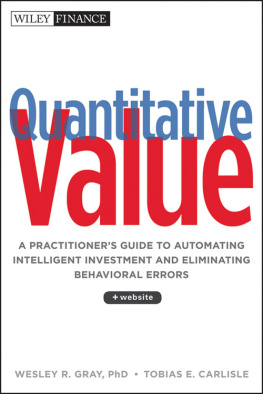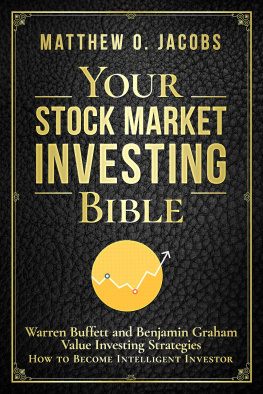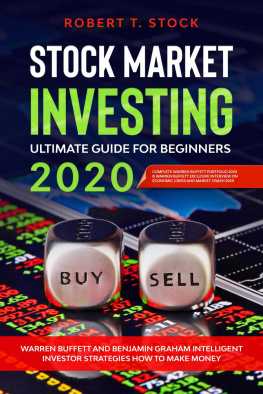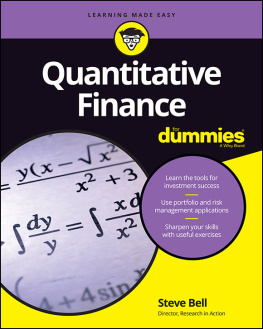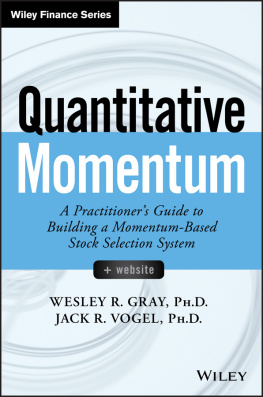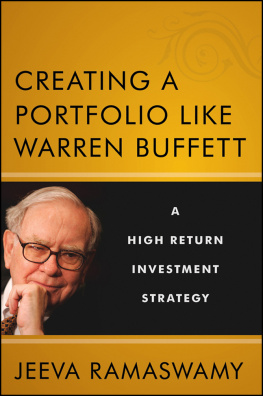
Founded in 1807, John Wiley & Sons is the oldest independent publishing company in the United States. With offices in North America, Europe, Australia and Asia, Wiley is globally committed to developing and marketing print and electronic products and services for our customers' professional and personal knowledge and understanding.
The Wiley Finance series contains books written specifically for finance and investment professionals as well as sophisticated individual investors and their financial advisors. Book topics range from portfolio management to e-commerce, risk management, financial engineering, valuation and financial instrument analysis, as well as much more.
For a list of available titles, visit our website at www.WileyFinance.com .

Cover design: John Wiley & Sons
Copyright 2013 by Wesley R. Gray and Tobias E. Carlisle. All rights reserved.
Published by John Wiley & Sons, Inc., Hoboken, New Jersey.
Published simultaneously in Canada.
No part of this publication may be reproduced, stored in a retrieval system, or transmitted in any form or by any means, electronic, mechanical, photocopying, recording, scanning, or otherwise, except as permitted under Section 107 or 108 of the 1976 United States Copyright Act, without either the prior written permission of the Publisher, or authorization through payment of the appropriate per-copy fee to the Copyright Clearance Center, Inc., 222 Rosewood Drive, Danvers, MA 01923, (978) 750-8400, fax (978) 646-8600, or on the Web at www.copyright.com . Requests to the Publisher for permission should be addressed to the Permissions Department, John Wiley & Sons, Inc., 111 River Street, Hoboken, NJ 07030, (201) 748-6011, fax (201) 748-6008, or online at www.wiley.com/go/permissions .
Limit of Liability/Disclaimer of Warranty: While the publisher and author have used their best efforts in preparing this book, they make no representations or warranties with respect to the accuracy or completeness of the contents of this book and specifically disclaim any implied warranties of merchantability or fitness for a particular purpose. No warranty may be created or extended by sales representatives or written sales materials. The advice and strategies contained herein may not be suitable for your situation. You should consult with a professional where appropriate. Neither the publisher nor author shall be liable for any loss of profit or any other commercial damages, including but not limited to special, incidental, consequential, or other damages.
For general information on our other products and services or for technical support, please contact our Customer Care Department within the United States at (800) 762-2974, outside the United States at (317) 572-3993 or fax (317) 572-4002.
Wiley publishes in a variety of print and electronic formats and by print-on-demand. Some material included with standard print versions of this book may not be included in e-books or in print-on-demand. If this book refers to media such as a CD or DVD that is not included in the version you purchased, you may download this material at http://booksupport.wiley.com . For more information about Wiley products, visit www.wiley.com .
Library of Congress Cataloging-in-Publication Data:
Gray, Wesley R.
Quantitative value + website : a practitioner's guide to automating intelligent investment and eliminating behavioral errors / Wesley R. Gray and Tobias E. Carlisle.
pages cm. (Wiley finance series)
Includes bibliographical references and index.
ISBN 978-1-118-32807-1 (cloth); ISBN 978-1-118-42000-3 (ebk); ISBN 978-1-118-41655-6 (ebk)
1. Investments--Psychological aspects. 2. InvestmentsDecision making. 3. Quantitative research. I. Carlisle, Tobias E., 1979- II. Title. III. Title: Quantitative value and website.
HG4515.15.G73 2013
332.6dc23
2012032321
For Nickole, without whom none of this is possible, andwith whom anything is possible.
Toby
To all my girls: Katie, Alice, and Glenda. Semper Fidelis.
Wes
Preface
This book is first and foremost about value investmenttreating stock as part ownership of a business valued through analysis of fundamental financial statement data. Benjamin Graham established the principles of value investing more than 75 years ago. Today, they are widely employed in the investment industry and generally accepted in academia. Its success as an investment philosophy is largely due to the investment performance of Graham's most famous student, Warren Buffett, whose shareholder letters have inspired multitudes to follow in his footsteps. Despite the widespread adoption of the philosophy, the exponential growth in computing power, and the ubiquity of financial data, the value phenomenon persists. It seems to defy logic. Why does the efficient market leave a free lunch on the table? The best answer is that the value phenomenon persists for the same reason it existed when Graham first conceived it: human beings behave irrationally. While investment tools have advanced, humans remain all too human, subject to the same cognitive biases that have plagued us since time immemorial. We may not be able to conquer these intrinsic behavioral weaknesses, but we can adapt our investment process to minimize them. The means to do so is the second aspect of this book: quantitative investment.
While the term quantitative likely conjures images of complex equations churned by powerful computers, it's best understood as the antidote to behavioral error. Our apparatus for reasoning under conditions of uncertainty is faulty, so much so that we are often entirely unaware of how imperfect it is because it blinds us to our failure. We are confidently incompetent. We need some means to protect us from our cognitive biases, and the quantitative method is that means. It serves both to protect us from our own behavioral errors and to exploit the behavioral errors of others. The model does need not be complex to achieve this end. In fact, the weight of evidence indicates that even simple statistical models outperform the best experts. It speaks to the diabolical nature of our faulty cognitive apparatus that those simple statistical models continue to outperform the best experts even when those same experts are given access to the models' output. This is as true for a value investor as it is for any other expert in any other field of endeavor.
This book is aimed at value investors. It's a humbling and maddening experience to compare active investment results with an analogous passive strategy. How can it be that so much effort appears to be wasted? (We use the word wasted euphemistically. A more honest expression might be value destroying.) The likely reason is that active managers unconsciouslybut systematicallyintroduce cognitive biases into the portfolio, and these biases lead to underperformance. It's not, however, our destiny to do so. There are several quantitative measures that lead to better performance, and these metrics will be familiar to any value investor: enhancing the margin of safety, identifying the highest-quality franchises, and finding the cheapest stocks. We canvass the research in each, test it in our own system, and then combine the best ideas in each category into a comprehensive quantitative value strategy. It's not passive indexing. It's active value investing performed systematically.
Acknowledgments
We are a lot like a turtle on top of a fencepostit's obvious we didn't get here alone. We have had enormous support from many colleagues, friends, and family in making this book a reality. First and foremost, Dr. Gray would like to thank Jack Vogel for his outstanding research and amazing dedication to accomplishing the mission. David Foulke played an integral role in the development of the book and made the book more accessible to nonquants. Carl Kanner and the rest of the crew at Empiritrage, LLCCliff Gray, Yang Xu, Tao Wang, and Shenglan Zhangread and reread the manuscript, ensuring it was democratizing quant at every step along the way. Katie Gray also played a key role in drafting the initial manuscript, ensuring it was easy to read and free of errors. Dr. Gray would also like to thank Drexel University's LeBow College of Business, and particularly his colleagues in the Department of Finance, for supporting his research agenda. Jared Wilson served as a dedicated research assistant and offered excellent advice and insights throughout the book-writing process. A number of colleagues at other institutions, notably Hui Chen at MIT, Steve Crawford at Rice University, Gil Sadka at Columbia, and Richard Price at Rice University, also provided valuable insights along the way. Robert Kanner and Edward Stern have been unfailing mentors in many of Dr. Gray's endeavors and particularly supportive in the development of the book, for which he is eternally grateful. When Dr. Gray's Popsicle stand finally takes flight, Bob and Eddie will be the reason for its success.
Next page
